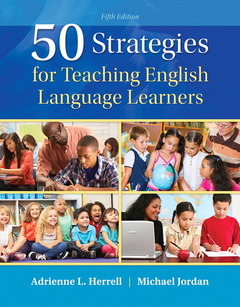Description
50 Strategies for Teaching English Language Learners (5th Ed.)
Author: HERRELL Adrienne L.
Language: English
Subject for 50 Strategies for Teaching English Language Learners :
Approximative price 50.62 €
In Print (Delivery period: 12 days).
Add to cart336 p. · Paperback
Description
/li>Contents
/li>
Preface
Theoretical Overview
Introduction to the Strategies
1 - Predictable Routines and Signals: Reducing Anxiety
2 - Total Physical Response and Total Physical Response Storytelling (TPR and TPRS):
Integrating Movement into Language Acquisition
3 - Modeled Talk: Demonstrating as You Talk
4 - Visual Scaffolding: Providing Language Support Through Visual Images
5 - Realia Strategies: Connecting Language Acquisition to the Real World
6 - Vocabulary Role Play: Building Word Knowledge through Dramatization
7 - Collecting and Processing Words: Making Vocabulary Your Own
8 - Manipulatives Strategies: Using Objects to Connect Concepts
9 - Read-Aloud Plus: Using Strategies to Support Comprehension
10 - Moving into Reading: Using Multiple Strategies to Foster Comprehension
11 - Close Reading: Engaging with Text to Improve Reading Comprehension
12 - Repeated Reading: Using Script Writing and Reader’s Theatre
13 - Scaffolding English Writing: Matching Instruction to Language Development
14 - Reporting Back: Verbal Practice in Curriculum Connections
15 - Leveled Questions: Adjusting Questioning Strategies to the Language Levels of Students
16 - Bilingual Books and Labels: Supporting Biliteracy Awareness
17 - Sorting Activities: Organizing Information into Categories
18 - Cloze: Using Context to Create Meaning
19 - Verb Action: Teaching Irregular verbs through Experience
20 - Syntax Surgery: Visually Manipulating English Grammar
21 - Checking for Understanding: Using Questioning Strategies to Differentiate Instruction
22 - Learning Centers: Extending Learning Through Hands-On Practice
23 - Communication Games: Creating Opportunities for Verbal Interaction
24 - Cognate Strategies: Using the Home Language to Support English Acquisition
25 - RTI for English Language learners: Documenting and Monitoring Student Progress and the Effectiveness of Intervention (RTI)
26 - Preview/Review: Building Vocabulary and Concepts to Support Understanding
27 - Story Reenactment: Making Stories Come to Life!
28 - Repetition and Innovation: Exploring a Book to Deepen Comprehension
29 - Language Focus Lessons: Support English Vocabulary and Structure Acquisition
30 - Graphic Organizers: Visually Representing Ideas, Text, and Connections
31 - Advance Organizers: Getting the Mind in Gear for Instruction
32 - Guided Reading: Providing Individual Support within a Group Setting
33 - Cohesion Links: Understanding the Glue That Holds Paragraphs Together
34 - Language Framework Planning: Supporting Academic Language and Content Acquisition
35 - Free Voluntary Reading: Nothing Helps Reading Like Reading
36 - Culture Studies: Learning Research Skills and Valuing Home Cultures in One Project
37 -Microselection: Finding Key Words and Main Ideas
38 - Read, Pair, Share: Working with a Partner to Negotiate Meaning
39 - Attribute Charting: Organizing Information to Support Understanding
40 - Integrated Curriculum Projects: Using Authentic Projects to Integrate Content Knowledge
41 - KWL and Data Charts: Researching and Organizing Information
42 - Collaborative Reading: What to Do When They Can’t Read the Textbook
43 - Cooperative Learning: Group Interactions to Accomplish Goals
44 - Learning Strategy Instruction: Acquiring Self-Help Skills
45 - Multiple Intelligences Strategies: Teaching and Testing to Student-Preferred Learning Modes
46 - Multimedia Presentations: Oral Reports for the New Millennium
47 -Small Groups and Partners: Interactions to Enhance Instruction
48 - GIST: Exploring Tough Text
49 - Tutorials: Closing the Achievement Gap
50 - Combining and Scheduling Strategies: Supporting Learning through Differentiation

